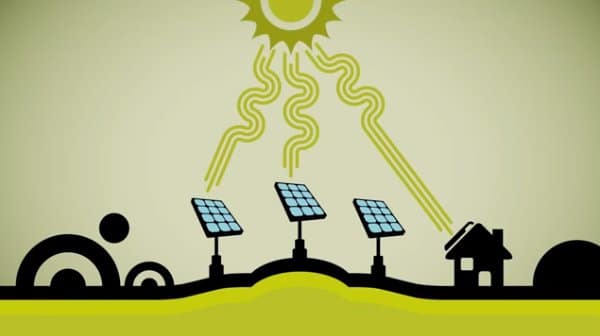When light strikes on hydrogenated amorphous silicon it exhibits a metastable change in the photovoltaic properties. When hydrogenated amorphous silicon is exposed prolonged to the light its efficiency to produce electricity decreases that is called Staebler Wronski Effect. This degradation of the electrical output of hydrogenated amorphous silicon is due to prolonged illumination. David L. Staebler and Christopher R. Wronski discovered this fact in 1977. The intensity of degradation depends on the diffusion coefficient of hydrogen and local bonding formation promoted by hydrogen.
Explanation of Staebler-Wronski Effect
The Stabler Wronski theory suggested that when intense light falls on hydrogenated amorphous silicon, the electron-hole pairs are created which again combine with neighboring Si-Si bonds that have weak foundationDuring recombination process the tremendous amount of energy is released which creates defects and causes degradation noncrystalline structure of the hydrogenated amorphous silicon. The recombinations occur especially in those regions where the band edges are very close to one another energetically and also have the smaller concentration of hydrogen. The breakage leads to enhanced hydrogen diffusion, and the creation of dangling bonds (H atom then forms a new bond with neighboring Si atom), and this reduces the flow of current by tapping electron-hole pairs. The movement of hydrogen atoms is responsible for the creation of dangling bonds. This phenomenon in hydrogenated amorphous silicon reduces the conversion of light energy into electrical energy. The Staebler Wronski effect reduces the efficiency of solar cell up to 15 % within the first 1,000 Hrs.
Factors which affects Staebler-Wronski Effect
- Hydrogen Concentration - Hydrogen concentration plays an important role in Staebler-Wronski Effect, which breaks further bonds and causing dangling bonds which obstruct flow of electrons.
- The Physical State of Silicon - It has been noted that hydrogenated amorphous silicon is more suitable for making the solar cell than nanocrystalline silicon. Amorphous silicon contains the substantial quantity of hydrogen which passivates Si dangling bonds and results in an improved electrical property. But it has the property of forming Si-H bond which degrades upon light soaking and attends a metastable state and this disorder of amorphous silicon suffers more from Staebler-Wronski effect.
- Concentration of Impurities - The efficiency of hydrogenated amorphous silicon depends on the material quality. Staebler-Wronski effect is associated with the concentration of impurities in the material and this effect causes blocking in annihilation. But now this theory does not hold good as it is well established by experiments that best quality of hydrogenated amorphous silicon (a-Si:H) has an inhomogeneous distribution of hydrogen and hydrogen increases the band gap in hydrogenated amorphous silicon, which creates density fluctuations.
- Temperature - The Staebler-Wronski effect is more effective below 400ok. But at high-temperature Staebler-Wronski effect reduces drastically. Heating the material above 200oC can anneal back the effect. After a sustained temperature, breakage by bond-pair is limited and healing beats breakages and recovery starts from there. The Staebler-Wronski effect disappears when the band gap falls below the critical level.
Methods to Overcome Staebler-Wronski Effect
- Use of polycrystalline, multi-crystalline or single-crystal silicon in place of amorphous silicon as they show more stability than a-Si.
- Working at high temperature as this effect disappears or becomes weak at high temperature.
- Use multijunction solar cell. In this cell, thin layers of amorphous silicon are stacked with some other materials to form a solar cell. When intense electric field passes through these amorphous silicon layers, the effect of Staebler-Wronski get reduced.
Paramagnetic Properties of Amorphous Silicon
The metastable defect of Amorphous Silicon shows paramagnetic properties that vary with respect to the microscopic environment. These defects of a-Si actually come in two types. One is uniformly distributed and other is concentrated in clusters within the internal surface of the cell during the manufacturing process. The clusters of defects are generated on the internal walls of microvoids which contribute to the light-induced degradation of amorphous silicon in the thin film solar cell.


 Now the n-type surface of the silicon crystal block is exposed to the sunlight. Some of the photons are absorbed by the silicon block. Some of the absorbed photon will have energy greater than the energy gap between valence and conduction band of valence electrons of the silicon atoms. Hence, some of the valence electrons in the covalent bond will be excited and jump out from the bond leaving behind a hole in the bond. In this way electron-hole pairs are generated in the crystal due to incident light. The holes of these light generated electron-hole pairs in the n-type side have enough probability of recombination with enormous electrons (majority carriers). Hence,
Now the n-type surface of the silicon crystal block is exposed to the sunlight. Some of the photons are absorbed by the silicon block. Some of the absorbed photon will have energy greater than the energy gap between valence and conduction band of valence electrons of the silicon atoms. Hence, some of the valence electrons in the covalent bond will be excited and jump out from the bond leaving behind a hole in the bond. In this way electron-hole pairs are generated in the crystal due to incident light. The holes of these light generated electron-hole pairs in the n-type side have enough probability of recombination with enormous electrons (majority carriers). Hence, 











 Where V is the
Where V is the 

